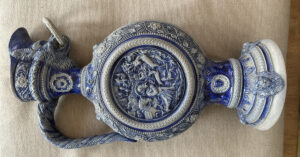 J owns a German saltware pottery ewer that couldn’t be more German if it tried. That style of blue relief decoration with a shiny surface dates back to the 14th century in Rhineland. This stoneware bears a salt glaze.
J owns a German saltware pottery ewer that couldn’t be more German if it tried. That style of blue relief decoration with a shiny surface dates back to the 14th century in Rhineland. This stoneware bears a salt glaze.
Potters in Germany discovered stoneware in the 13th century when they found that a hot enough kiln produced vitrification. This term means a porous material became nonporous when the minerals in the clay fuse together. Before this discovery they formed drinking vessels with low fired clay, which became a breeding ground for disease. Wooden tankards came with the same malady. Stoneware doesn’t need a glazed surface, but a glaze adds to the decorative element and helps keep the vessel pristine.
How did potters discover salt glazing?
The Rhineland transported fish packed with salt in wooden barrels and boxes. Broken down boxes became fuel for pottery kilns, leading to the discovery of salt glaze. Salt, when added to the firing process in a kiln at a high temperature (1,300 degrees Celsius) creates a nonporous shiny stoneware which safely contain liquids. A famous location for the type of raised relief decoration seen on J’s wheel-shaped ewer is Hohr-Genzhausen in Rhineland-Pfalz. There potters created this distinctive stoneware called Grenzaue-ware from the 1580s. They considered these age-old traditional firing methods earth-shattering technological discoveries in their day.
In the Westerwald area, another important region for salt-glazed stoneware, potters decorate gray clay through the application of molds and incising. Raised patterns, called the relief, are accentuated with a dark blue glaze formed from cobalt oxide. One of the forms famous in the area are handled drinking vessels called the krug. As opposed to the stein: the German word for stone, because they thought the material stoneware to be as hard as a stone. The krug’s is typically bulbous in the middle of the vessel and geometric, artistically applied decoration emphasizes this.
Traditional German saltware has been closely identified with the German domestic table for centuries. Think of those robust blue/gray steins of beer, massive, lidded bowls for sauerbraten, weighty stoneware platters for wurst and thick brown bread.
Notice the central circular relief decoration on the thirteen inch ewer. It features a saint (well, we see a halo) dressed in a medieval hunter’s costume. A large stag stands at the forefront of the action. The saint dismounted or fell from his horse. Around him sport three hunting dogs. One dog looks back at the saint in surprise, while in pursuit of the stag. This saintly figure represents St. Hubert (656-727AD), the patron saint of ethical, compassionate hunting.
Here’s the Myth
One Good Friday when all villagers went to church, Hubert pursued a most beautiful stag. In hot pursuit on horseback, the stately creature turned to look at the hunter, lifted its head. Suddenly a crucifix appeared between its antlers. Hubert leapt from his horse and fell prostrate before the apparition. When he arose, his life changed. Hubert gave his wealth to the poor on his return to his village and studied for priesthood, fasting and praying. He became the Bishop of Liege in 708AD. His feast day is May 30.
Notice the ewer’s spigot in the shape of another popular animal of the hunt, the German tusked wild boar, a big game animal that remains fierce well into their old age at 7 years. Wild boars roam the mountainous regions of Bavaria. If threatened they charge at 30mph and leap over fences up to three feet tall. The wild boar’s face on the ewer holds a ring in its mouth, a suggestion of its domesticated cousin, the pig.
Strangely enough, the base of the ewer features a lion’s heads, not a creature that roams the Bavarian countryside. A grapevine design in relief indicates the vessel poured wine.
Stoneware became important from the 15th to the 19th century because of its durability and use for secure storage. By the 16th century German stoneware was exported all over central Europe and Britian, and German potters included relief portraits of English and French kings, depending on the imported country. The lowly salt glazed stoneware krug or stein became one of the first forms internationally traded.
J’s ewer is mid to late 19th century, hearkening back to the Northern Renaissance 17th century style (old stoneware is worth more), and is $300.